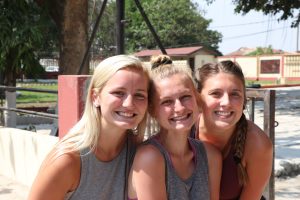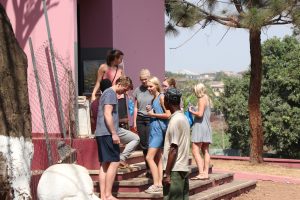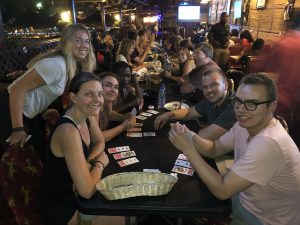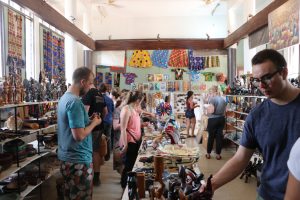Blogpost for January 26, 2019
After a long journey yesterday through the rolling hills, scattered with small villages and palm trees, we arrived in Kumasi. We were all exhausted and slept like new babies.
This morning, we woke up in the cozy Davellen Hotel and had a big breakfast of omelettes, oatmeal, bread, and fruits. We packed up the bus and were on the road again to the Manhyia Palace Museum. We went on an extensive tour of the Manhyia Palace, an.old palace of the Asantehene, built by the British I’m 1925, for king Prempeh I, who was returning from exile in Seychelles.

To summarize what we learned, here are a few key points:
– The Asante are a large kingdom of people in central Ghana that was founded in 1685 after the unification of many smaller states.

– The 13th King of the Asante people, Prempeh, became king at age 18. King Prempeh was given the Manhyia Palace by the British in 1925, after they had burnt down the first in the Segarante war of 1874, and upon his return from exile in the Seychelles, where he spent 28 years. Though the guide said, prempeh did not accept the palace until the Asante people paid for it, but he did not also provide information on where he lived upon his return.
– The most important item to the Asante people is the golden stool. It is believed to have arrived to the first King from God.
– Sir Fredrick Hodgson demanded that the golden stool be handed over to the British during the colonial era. Queen Yaa Asantewa quickly had a replica made of the gold stool and handed it over to the British. Once the British had discovered her deception, she was exiled to Seychelles, where she later died.
– The 14th King named Otumfuo Opuko Ware II lived in the Manhyia Palace from 1931 until 1970 and in 1995 he converted the old palace into a museum.
We questioned why the tour guide did not discuss slavery as a part of Asante history. The guide tried to distance Asante from the slave trade, stating that it was the British who captured slave but the Asante only went to war for territorial expansion. Of course, through these wars slaves were gotten, and sold old. Asante was one of the mighty slave kingdoms of West Africa. We noticed that there was a silencing of slavery and repositioning of the Asante role within the history of the slave trade.
Is it guilt or shame? These are some of the questions the class will grapple with. Meanwhile, as a class, and on the bus, we came up with various answers to why the Asante have chosen to disregard their past. We thought that because the Asante kingdom is so powerful, speaking about slavery brings shame. It also indicates the desire to maintain a position of ‘rightness’ and morality in the history of the Asante region, and attempts to diminish resentment from those who suffered from their slaving activities, and for their role in the slave trade.

Other issues that came out had to do with Asante relations with people to the north and how much borrowing has taken place. A question on the taking drums led to the claim by the guide that it was introduced by an Asanteman, to which Prof. Iddrisu questioned the Asante name of “Atimpane”, and said it was a corruption from the Dagomba “timpana.” The talking drum is essentially a Dagomba thing. Other drums found at the palace and in Asante are Dagomba.
The second issue related to ancestry. The guide told us Asantes had intermarried with the MogoNabe’s people of the Moshi and a reason they are tall, pointing to gift from the MogoNaba. A flimsy evidence. But then the Asantehene in national TV and in audiencee with the president of Ghana, mentioned their relations with the Dagomba people. Yes, the king is descendant from Naa Garba, a seventeenth century king of Dagbon, who gave his sister to the Asantehene. The current Yaa Naa has taken that name and was outsourced a few days ago as Naa Garba II. It’s an issue of retelling and a desire by people to change the history. But even then, the guide can not be blamed, for he lacked the knowledge of a guide of such a place as crucial as this museum.
After our tour we hopped on the bus for another delish meal at Ike’s.

We made a quick stop at the Kumasi cultural center to pick up a few more souvenirs and artwork before we were finally on our way to Accra. The trip was long, but luckily the scenery was beautiful. The landscape consisted of lush green covered mountains and the roads were lined with people selling fresh fruits and vegetables.

We arrived in Accra a little after 8:00pm and were greeted by the friendly workers at the Pink Hostel and the Guest House. Some students helped themselves to a little dinner at the Pink Hostel, but most of us took a warm shower and went right to bed.
Love,
Ella, Kristina, Morgan, and Vanessa
